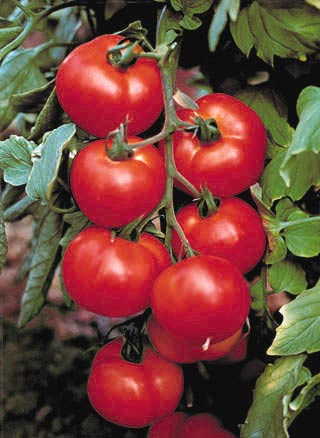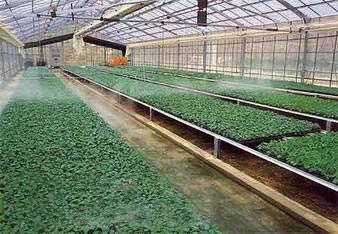Indoor ground - The experience of Israel.
Over the past two decades, the area of greenhouses in Israel has more than  tripled, from 900 hectares in 1980 to over 3,000 hectares today. This was not caused by any extraordinary circumstances, it is just that the greenhouse allows you to get a guaranteed harvest, regardless of the restrictions imposed by nature, such as soil and climatic conditions, low or too high temperatures, and water supply.
tripled, from 900 hectares in 1980 to over 3,000 hectares today. This was not caused by any extraordinary circumstances, it is just that the greenhouse allows you to get a guaranteed harvest, regardless of the restrictions imposed by nature, such as soil and climatic conditions, low or too high temperatures, and water supply.
Greenhouses in Israel are mainly used for the cultivation of flowers, vegetables, spices, ornamental plants, seedlings, and seedlings. However, recent experiments have shown that greenhouses are also suitable for growing fruit trees. The latest plastic-coated greenhouse designs have recently come into use even in aquaculture, and for keeping livestock and poultry.
The agricultural industry manufactures and exports a wide range of varied greenhouses
From simple structures, up to projects equipped with turnkey computer control and management systems. Not only supporting structures are produced, but also plastic sheeting, irrigation and fertigation systems, special equipment for harvesting, sorting, packaging, and storing crops, devices, hardware, and software for controlling and regulating microclimate, energy and water saving. In addition, for those who want our package to be complete, we recommend the varieties and seeds most suitable for greenhouses, fertilizers, and soil substitutes.
structures, up to projects equipped with turnkey computer control and management systems. Not only supporting structures are produced, but also plastic sheeting, irrigation and fertigation systems, special equipment for harvesting, sorting, packaging, and storing crops, devices, hardware, and software for controlling and regulating microclimate, energy and water saving. In addition, for those who want our package to be complete, we recommend the varieties and seeds most suitable for greenhouses, fertilizers, and soil substitutes.
The current Israeli greenhouses have features such as sunshades and heat-preserving screens that automatically move based on the intensity of solar radiation. Special plastic coatings (film) for greenhouses have been created, which correct the spectrum of light passing through them and affect plant growth. They filter and convert harmful ultraviolet radiation into infrared and increase photosynthesis. Newly developed special nets protect greenhouses from pests, including whitefly, when ventilated. This development reduces insect damage to plants and also reduces the need for chemical treatments. A modern greenhouse allows you to fully control most of the technological parameters, as well as maximize the use of the area and optimally distribute the cultivation of products during the farming seasons. The result is a significant increase in product production. Israeli farmers grow on average up to 3 million roses per hectare of greenhouses per season. And about 300 tons of tomatoes per hectare per season, which is four times more than in the open field. These latest materials, equipment, and technologies are available to our foreign clients ordering greenhouse projects from us.
Vegetables
In Israel, vegetable cultivation has become an art based on the use of hybrid seeds, fertilization combined with irrigation, varieties of materials was specially developed  for this type of plant, and the use of advanced systems for processing and storing the harvested crops. Vegetables make up about 17 percent of Israel's total agricultural production. In 1996, the country's farmers produced about 1.7 million tons of vegetables. Most were used fresh, about 150,000 tons were exported and the rest was processed by the food industry. A large number of processed vegetables were also exported. (About 1,800 hectares of vegetables, a third of the total production, are grown in greenhouses)
for this type of plant, and the use of advanced systems for processing and storing the harvested crops. Vegetables make up about 17 percent of Israel's total agricultural production. In 1996, the country's farmers produced about 1.7 million tons of vegetables. Most were used fresh, about 150,000 tons were exported and the rest was processed by the food industry. A large number of processed vegetables were also exported. (About 1,800 hectares of vegetables, a third of the total production, are grown in greenhouses)
Due to the wide variety of climatic and topographic conditions in the country, various technologies and methods of growing vegetables are used, including drip irrigation, greenhouses with climate control systems, and a method of growing in a small-volume artificial substrate. Low-volume technology eliminates many of the disadvantages inherent in traditional technology and allows more control over-irrigation and maturation.
Tomatoes are grown in open ground reach yields of up to 80 tons per hectare. The average yield in greenhouses of 200-300 tons can be obtained under a controlled climate. The maximum yield reaches 500 tons. The climatic conditions in Israel, the sun, and the relatively high temperatures allow the production of high-quality vegetables in the off-season, making the products competitive.
Recently, there has also been a significant increase in the production of organic vegetables. This area of production generates $ 10 million annually in exports, including protected and open ground. Organic technologies are used to grow carrots, potatoes, deciduous green vegetables in the open field, and in greenhouses, it mainly grows cherry tomatoes, ordinary tomatoes, cucumbers, and zucchini.
A large number of new varieties and hybrids have been developed in Israel, which are in great demand and are exported to many countries of the world. Many varieties are especially suitable for indoor and hot climates.
Pictured: Vegetable greenhouse. Tomatoes.
Seedling production
 Seedling production in Israel is a very powerful separate industry. The overwhelming majority of all plantings of vegetables, greens, flowers, and other plants are made only by the seedling method. This branch of agricultural production is excellently equipped and corresponds more to industrial than agricultural production. All seedlings are grown in cassettes, which makes it possible to get almost one hundred percent survival rate when planting in the open or protected ground. The root system with a lump of the substrate, keeps the roots intact during transport and planting. This technology allows the use of high-quality hybrid seeds since practically every seed grows a plant and the cost of planting material is not too high, despite the high cost of hybrid seeds. Most of the technological processes for growing seedlings are automated.
Seedling production in Israel is a very powerful separate industry. The overwhelming majority of all plantings of vegetables, greens, flowers, and other plants are made only by the seedling method. This branch of agricultural production is excellently equipped and corresponds more to industrial than agricultural production. All seedlings are grown in cassettes, which makes it possible to get almost one hundred percent survival rate when planting in the open or protected ground. The root system with a lump of the substrate, keeps the roots intact during transport and planting. This technology allows the use of high-quality hybrid seeds since practically every seed grows a plant and the cost of planting material is not too high, despite the high cost of hybrid seeds. Most of the technological processes for growing seedlings are automated.
Seedlings and seedlings grown in specialized greenhouses are also exported to many countries. All seeds and planting material are subject to very high-quality requirements.
Pictured: A greenhouse for growing vegetable seedlings.
FLOWERS
Despite the relatively small dimensions by international standards  (the average farm is about a hectare in size), The Israeli flower sector is very productive and highly profitable, and the deep knowledge of farmers contributes to the fact that they grow high-quality flowers in a wide range (over 200 varieties) for the domestic and foreign markets. The main range includes roses, carnations, gypsophila, solidago, gerbera, anemones, lemongrass, and ornamental plants. Much attention is paid to the acclimatization of new varieties, especially those with export potential. This trend includes the so-called "summer flowers from Europe, acclimatized for cultivation and export during the winter season to European markets. There is active acclimatization of various types of flowers from the southern hemisphere, selection of local varieties, and the acclimatization of wildflower species with commercial potential. About eighty percent of the production is sold at German and Dutch auctions, the rest is sold in Europe, USA and Israel through direct sales in retail markets.
(the average farm is about a hectare in size), The Israeli flower sector is very productive and highly profitable, and the deep knowledge of farmers contributes to the fact that they grow high-quality flowers in a wide range (over 200 varieties) for the domestic and foreign markets. The main range includes roses, carnations, gypsophila, solidago, gerbera, anemones, lemongrass, and ornamental plants. Much attention is paid to the acclimatization of new varieties, especially those with export potential. This trend includes the so-called "summer flowers from Europe, acclimatized for cultivation and export during the winter season to European markets. There is active acclimatization of various types of flowers from the southern hemisphere, selection of local varieties, and the acclimatization of wildflower species with commercial potential. About eighty percent of the production is sold at German and Dutch auctions, the rest is sold in Europe, USA and Israel through direct sales in retail markets.
Pictured on the right: Agribusiness Course in Israel. A group from Russia in one of the flower greenhouses of the Shahar moshav.
INCREASING EFFICIENCY
Although the number of growers such as flower growers has more than halved over the past few years (from 5,000 to 2,000), production has grown steadily to reach about 1.6 billion flowers per year, as a result of technological innovation and an intensive production system. About 50 percent of all flower production is grown in advanced, automated greenhouses, and approximately 12 percent is grown under netting. The most recent innovation is the construction of the first of several greenhouse complexes in which farmers grow flowers in rented greenhouses equipped with the most advanced systems and all the necessary infrastructure and related services.